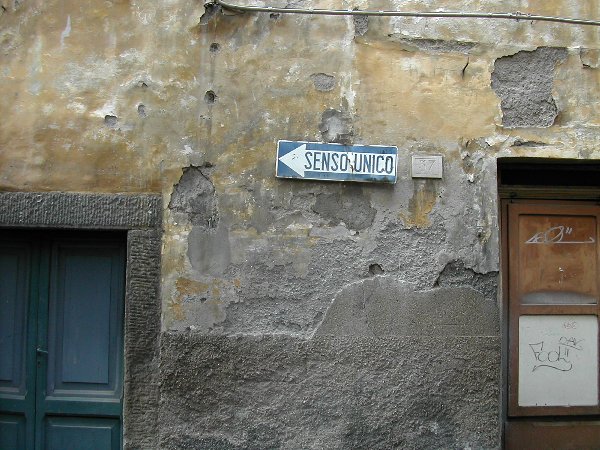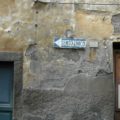One side effect of living in Lecco is that I need to drive. Not so much to get around Lecco itself, nor even into Milan, but because our fourth family member, Hamish the horse, now lives in a place not easily reached by public transport. (Yes, there are buses, but they don’t run very often.) So it’s time to get an Italian driving license; the grace period for driving on my American one expired about 12 years ago.
Unfortunately, American licenses are not directly convertible to Italian; you have to go through the same process as an Italian first-time driver. This is far more difficult and longer than getting a license in the United States; I think that’s a good thing, given the challenges of driving in Italy.
The first step to getting a license is to pay three different fees (a total of 33 euros), and have a medical exam of sorts, mostly about vision. That plus filling out some forms gets you a foglio rosa (pink sheet) – a learner’s permit. I am doing all this through a driving school, which is costly, but makes things somewhat easier: they take care of the paperwork and standing in line for you.
Then you have to pass a written “theory” test. It’s only 30 true-or-false questions (three each on 10 topics), but if you miss more than four, you have to wait a month and a day before you can try again, and the test is harder than it looks: it demands a thorough understanding of Italian legal/bureaucratic language, at least as relates to driving. Immigrants not fluent in Italian have the option to take a much easier oral test; I could probably have gotten away with claiming this, but the oral would have taken longer to schedule, so I opted for the written.
The driving school offers theory lessons three times a week. I went to two of these, but found them excruciatingly dull. It’s no doubt great for beginners and non-fluent immigrants to have everything explained six times over, but I find it hard enough to sit through any class for 90 minutes, let alone “Road Signs for Dummies”. The only interesting part was the teacher’s endless stock of horrible stories about drivers who became distracted and “ci ha lasciato la pelle” (literally, “he left his skin,” meaning “he died”). According to the teacher, the major cause of road accidents is: “Dis- dis- …?” (prompting for the word). “Disregard for the rules?” I was tempted to offer, but I kept my mouth shut; I’d already seen that he didn’t understand my sense of humor. The answer he was looking for was “Disattention,” which I suffered in his class more than I ever have on the road.
Fortunately, the classes were not required, and I already had another source of help on Italian driving theory. Cristina, a member of the Expats in Italy online group I frequent, has a very helpful website about driving in Italy, which in turn links to WebPatente, a useful program for learning the theory and practicing for the exam, complete with audio commentary on your results.
The questions asked in the practice exams are presumably based on real exams past and present. The funniest one I ran across in my hours of practice was: “True or False: Distraction and a reduced sense of danger can be caused by… excessively spiced foods.”
This is almost as funny as the question my dad had to answer in a driving test in Indonesia, years ago:
You’re driving down the road and you see a Stop sign. You should:
a. Stop
b. Slow down.
c. Look to see if a policeman is watching.
Meanwhile, back in Italy… I had to argue with Mr. Realini, the owner of the driving school, to convince him that I could prepare myself for the exam without the help of their classes or preparatory quizzes. (NB: My attending or not made no difference to the amount of money they’re getting out of me: a flat fee of 500 euros, plus however many driving lessons at 23 euros each) But, after a couple of nasty head-on collisions with me, he agreed to schedule it for September 22nd.
So I turned up at the school at 10:45 Monday morning. Then had a last-minute panic, because I suddenly realized that the foglio rosa was required for entrance to the exam, and it had vanished from my wallet. I ran home to search (I had time because the earlier exam sessions were running late), but couldn’t find it. Mr. Realini was nice about it (“Happens all the time”), and said we should just go to the exam anyway and see if they would let me in. So myself and four 18-year-olds trooped across the street to the Motorizzazione Civile (“Civil Motoring”? not a very accurate description, in Italy), where two dozen other candidates were waiting, with the owners of their respective driving schools. Mr. Realini, perhaps to distract me, asked what I thought of George Bush, so we had a lively discussion about that. The teenagers were amused, but shy to join in.
Around 12:15 we were finally allowed into the exam room. Our names were called off a computer printout, and each of us had to stand in front of the two examiners while our packet of papers and photo ID were scrutinized. They waved away my lack of a foglio rosa, but wanted to see my permesso di soggiorno (permission to stay in Italy), which I hadn’t known I was supposed to have with me. But at least I knew exactly where that was. I started to call Enrico to bring it (he’d already spent an hour searching for the foglio rosa), but then they decided that I only needed it for the actual driving test.
When all the candidates had been checked in, the examiners asked two people to come up and witness (with signatures) that the exam packets were still sealed. They then opened the packets, and one of them signed each exam sheet before tucking one into each student’s portfolio of papers. Then he called us up one by one to collect our packets. Finally, when all were seated with our papers in front of us, we were allowed to take the sheets out and start the exam.
Almost immediately, a vociferous argument started in the main office outside. I giggled. The examiner smiled ruefully and closed the doors, but you could still hear everything. Finally he poked his head out the door and asked if they could carry on after the exam. A minute later, someone poked his head in to apologize. “Just for this, you all pass,” he joked.
Of course, the first topic on the exam was something that had not come up in the driving school handbook nor WebPatente, about directional signage for roundabouts (which have only recently become popular in Italy). The wording on one of the three questions looked like it might be one of those linguistic traps: is a road coming off a roundabout called a traversa (cross-street), or is there some arcane technical term that I hadn’t heard before? After some pondering, and going on to do most of the other questions, I marked it “false.” You can’t make corrections on this test, so you have to be sure of the answer when you make your mark!
The rest of the test I felt pretty comfortable about, except the questions about the round blue sign with a human figure walking. I was mostly, but not entirely, sure that that meant “pedestrian area,” and answered the questions accordingly.
There was also a question on precedenza (right of way), my favorite subject – just because the rules are so charmingly contrary to actual behavior. The tests use some wildly theoretical intersections, with five or six streets meeting. The situations are all plausible enough, but the correct answers are not. One that sticks in my mind shows a four-lane street with a tram (on tracks) in the middle, flanked by a truck going the same direction. There are cars waiting to cross from each side of a smaller cross-street. Theoretically, the tram goes first, because any vehicle on tracks always has right of way. After that, the car with no traffic to its right should go, then the other car, and the truck last. Yeah, right – try to convince me that, in real life, the truck isn’t going to move at the same time the tram does, or even before! The book does reiterate that, no matter what the rule of precedenza says in any given situation, you should make sure that the other drivers agree with you before you move.
The test sheet was printed in black and white, including the illustrations, but there were two colored brochures of road signs and street diagrams that you could consult for clarity (each picture used in the test is numbered; the images in the brochures have matching numbers). I realized after I had handed in my test that a careful look through the whole brochure would have resolved the pedestrian zone question for me: the sign was there, by itself, just as shown on the test, but there was also another version of it as part of a larger sign with “zona pedonale” clearly printed!
We had 30 minutes to complete the test, but no one took that long. By around 20 minutes, the last test had been handed in, and we proceeded to corrections. Again each person’s name was called, and we had to stand in front of the examiners while they checked the test against the marking sheet, and called out the number of errors with “idoneo” or “non idoneo” (suitable or un-). Only two people failed, one with five errors, one with “many.” I only had one error, on that question about the roundabout, which turned out not to have been a trick after all. So I am suitable for driving – at least in theory.
When told my result, I did the American fist-pump gesture and shouted “Yes!” The other examinees all laughed; one of the examiners said disapprovingly (in Italian): “You’re in Italy now, say Si’.”
October 6, 2003
My classmate Yuti responded:
“This reminds me of my driving test in Bombay in 1981 when I turned 18. The test is supposed consist of an oral test and a test drive. There is a fat rule book, but I was told by my driving instructor that examiners ask only one of three rules, so I was to remember only these, and not bother with the rest. I don’t remember the rules verbatim but they go something like this: (1) you cannot have someone sitting on the car bonnet while the car is in motion, (2) you cannot have more than three persons in the front (in those days cars did not have bucket seats, but one long seat like the back), and (3) you cannot drive without headlights at night. These rules had numbers, like Rule 356, 452, etc.
The examiner would ask “Recite Rule so-and-so”, and you were expected to recite the rule verbatim as per the Rule book. Sure enough, my examiner asked me to recite the rule about sitting on the bonnet. That was the extent of my oral test.
For my test drive, I was asked to reverse park between two cars, and indicate turning left and right. In those days, Indian cars did not have turn indicators, so you had to use your hands. To turn right, you stuck your hand out of the window and made a circular motion with your wrist in a clock-wise direction. To indicate a left turn, you turned your wrist anti-clockwise. It took me 10 minutes to pass both tests. I got my license within a week by bribing the examiner Rs.50 (a hefty bribe in 1981), otherwise I would have waited months for it. But I was in a hurry to hit the road.
Now you know why Indians drive the way they do!”





plsss help me i need to learn a driving lesson here in italy
This is so funny!!!!! i laughed the entire time because am having nearly the same problem. I just relocated to Italy and i desperately need a patente because the buses are painful to wait for. I come from Kenya where moving about has never been an issue. Infatti it was easier getting about by public transport than private cars. Here you have to pray that the bus driver is in a good mood to come fast.
hello plz anyone can tell me that can i give this itlaian theory in english i mean theory test for driving lisence plz help me ….. me4you@live.no
How can get I driving license in Italia . But only in English test conditions
I Also waiting for this anwer but i dont think so
Italy driving theory test have in English language?
Maybe with Italian superstitions, spicy foods do cause impairment!!
Anyway thank you for sharing your experience. I hope it provides me with valuable support in the process.